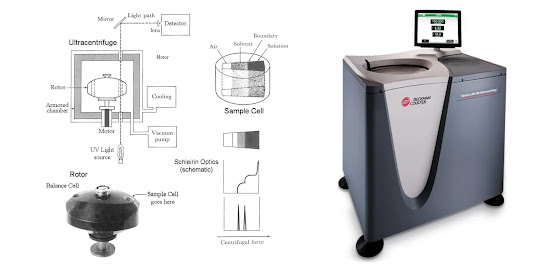Ultracentrifuge - Principle, Types, Procedure, Applications
Ultracentrifugation is a specialized technique used to spin samples at exceptionally high speeds. Current ultracentrifuges can spin to as much as 150 000 rotations per minute (rpm) (equivalent to 1 000 000 g). However, extreme centrifugal forces may cause overheating, so to avoid sample damage, ultracentrifuges are equipped with vacuum systems that keep a constant temperature in the centrifuge’s rotor.
Centrifugation, and ultracentrifugation, is nowadays, at the
core of the laboratory routine. Benchtop centrifuges are essential devices in
any biology or chemistry laboratory, and they are used on a day-to-day basis in
a wide range of experimental protocols, from concentrating solutions to
isolating cells and subcellular components. Ultracentrifugation widened the
applications of benchtop centrifugation, allowing the isolation of smaller
sized particles, and the study of purified molecules and molecular complexes.
In biology, the development of ultracentrifugation in the early 1900s, widened
the possibilities of scientific research to the subcellular level, allowing for
the differential separation of cellular components, such as organelles, lipid
membranes, and even to purify proteins and ribonucleic acids (DNA and RNA).
Ultracentrifuge Definition
Ultracentrifuge is a sophisticated and advanced centrifuge that operates at an extremely high speed and separates smaller molecules that cannot be separated from the traditional centrifuges.
- The speed of the rotors in ultracentrifuge can range from 60,000 rpm to 150,000 rpm.
- Ultracentrifuges are mostly operated in more facilitated laboratories to perform more advanced operations.
- These are larger in size and can operate samples either in batches or as a continuous flow system.
- Most ultracentrifuges are refrigerated in order to control the heat that might be generated due to the excessive speed.
Principle of Ultracentrifuge
- The ultracentrifuge works on the same principle as all other centrifuges.
- The working of an ultracentrifuge is based on the sedimentation principle, which states that the denser particles settle down faster when compared to less dense particles under gravity.
- However, the sedimentation of particles under gravity would take a larger amount of time, and that is why an additional force is applied to aid the sedimentation process.
- In an ultracentrifuge, the sample is rotated about an axis, resulting in a perpendicular force, called centrifugal force, that acts on different particles on the sample.
- The larger molecules move faster, whereas the smaller molecules move slower.
- At the same time, denser molecules are moved outwards to the periphery of the tubes whereas the less dense molecules are rotated towards the center of the tube.
- Once the process is completed, the larger and more dense particles settle down, forming pellets at the bottom of the tube. In comparison, the smaller and less dense particles remain either in the suspended in the supernatant or float on the surface.
Types of Ultracentrifuge
Based on the application and purpose, ultracentrifuge are of
two types;
1. Analytical ultracentrifuge (AUC)
- Analytical centrifuges, as the name suggests, are the ultracentrifuges that are used for the analysis of various particles present in the sample.
- Analytical ultracentrifugation (AUC) is a versatile and robust method for the quantitative analysis of macromolecules in solution
- These ultracentrifuges have detection systems to monitor the spinning and position of the particles in real-time to determine the sedimentation coefficient that aids in the analysis of particles based on shape, size, and masses.
- Analytical ultracentrifugation for the determination of the relative molecular mass of a macromolecule can be performed by a sedimentation velocity approach or sedimentation equilibrium methodology.
- The hydrodynamic properties of macromolecules are described by their sedimentation coefficients. The coefficients can be determined from the rate that a concentration boundary of the particular biomolecules moves in the gravitational field.
- The sedimentation coefficient can be used to characterize changes in the size and shape of macromolecules with changing experimental conditions.
- Three optical systems are available for the analytical ultracentrifuge (absorbance, interference, and fluorescence) that permit precise and selective observation of sedimentation in real-time.
- One of the examples of the detection systems used in ultracentrifuge is the Schlieren optical system that observes the particles in the centrifuge in real-time to determine their position and movement.
- Based on the position, the sedimentation coefficients can be determined, which allows the determination of properties of different molecules.
- Analytical ultracentrifuge is most commonly used for the determination of properties of biomolecules like proteins and nucleic acids.
2. Preparative ultracentrifuge
- Preparative ultracentrifuges are the centrifuges that are primarily used for the isolation and separation of particles in a sample by the process of centrifugation.
- In a preparative run of an ultracentrifuge, the contents of the tubes are analyzed after the centrifugation period, unlike the analytical centrifuge where the analysis is done during the centrifugation process.
- Preparative ultracentrifuges can be operated for different types of centrifugation processes like density gradient centrifugation, differential centrifugation, and isopycnic centrifugation.
- The particles in a sample are either separated on the basis of their density or their sizes.
- In density gradient centrifugation and isopycnic centrifugation, the particles of a sample are separated on the basis of their density. Different particles present in a sample are isolated in the form of bands in distinct levels where the density of the particle equals the density of the medium.
- In differential centrifugation, however, the particles are separated by applying different speeds of the rotors. Larger particles settle down under lower speeds while smaller particles require higher speed for separation.
- Because particles are separated on the basis of density and size, preparative ultracentrifuges can be used for the determination of the density and size of different particles.
Instrumentation/ Parts of Ultracentrifuge
- Ultracentrifuges are provided with a variety of parts and components perform different functions.
- The rotors are an essential part of any ultracentrifuge. Ultracentrifuges use all three types of rotors, namely, vertical rotors, swinging bucket rotors, and fixed-angle rotors.
- The swinging bucket rotor is the most commonly used rotor in ultracentrifuge because this yields the highest concentration of particles. This is because the direction of centrifugal force in vertical rotors aligns with the position of the tubes.
- The drive is the power unit which spins the rotor holding cells or tubes which contain the solution of molecules or suspension of particles.
- Besides the interchangeable electric drive and rotors, it includes analytical rotors accommodating up to four cells, temperature devices with range and control from 0° to 40°, cells with thicknesses covering a factor of 10 in the sensitivity, and wedge quartz windows permitting several cells to be used simultaneously.
- The temperature system allows the control of temperature in the system as heat production is common during the operation of ultracentrifuge at high speeds.
- Analytical ultracentrifuge also has a two-dimensional comparator with a printing desk calculator, interference, and absorption optical systems. The optical systems are necessary for the real-time analysis of molecules.
- Additionally, a gradient-forming device, hand refractometers, and a recording spectrophotometer with flow cell and fraction collector might also be present in a preparative ultracentrifuge.
Procedure/ Steps of Ultracentrifuge
The process of operating an ultracentrifuge might differ depending on whether it is an analytical ultracentrifuge or a preparative ultracentrifuge. In general, the following are the steps to be followed while performing analytical ultracentrifugation:
- Small sample sizes (20-120 mm3) are taken in analytical cells to be placed inside the ultracentrifuge.
- The ultracentrifuge is then operated so that the centrifugal force causes a migration of the randomly distributed biomolecules through the solvent radially outwards from the center of rotation.
- The distance of the molecules from the center is determined through the Schlieren optical system.
- A graph is drawn from the solute concentration versus the squared radial distance from the center of rotation, based on which the molecular mass is determined.
The following is the procedure for the operation of a preparative ultracentrifuge:
1. Density gradient centrifugation
- In preparative ultracentrifuge using density gradient, a density gradient has to be prepared. For this, a layer of less concentrated sucrose is applied over a layer of more concentrated sucrose which creates a sucrose density gradient. Some ultracentrifuges come with gradient-forming devices that can make the gradient by themselves.
- Then the sample is placed in the centrifuge tube over the gradient, and then the tubes are placed in the racks of the rotors of the ultracentrifuges.
- The temperature and time are set in the ultracentrifuge before the process is started.
- The lid is closed, and the process is started.
- The particles travel through the gradient until they reach a point at which their density matches the density of the surrounding medium.
- The fractions are removed and separated, obtaining the particles as isolated units.
2. Differential centrifugation
- In differential centrifugation, the sample is homogenized in the medium containing buffer.
- The sample is then placed in the centrifuge tube, which is operated at a particular centrifugal force for a specific time at a particular temperature.
- By the end of this operation, a pellet will be formed at the bottom of the tube, which is separated from the supernatant.
- The supernatant is added to a new centrifuge tube where it is centrifuged at another speed for a particular time and particular temperature.
- Again, the supernatant is separated from the pellets formed.
- These steps are continued until all particles are separated from each other.
- The particles can then be identified by testing for indicators that are unique to the specific particles.
Applications of Ultracentrifuge
- Preparative ultracentrifuges are used in biology for a pelleting fraction of cell organelles like mitochondria, ribosomes, and even viruses.
- Density gradient centrifugation uses cesium salt gradients for the separation of nucleic acids like DNA and RNA.
- Analytical ultracentrifuge allows the detection and characterization of macromolecular conformational changes due to changes in pH, temperature, and other environmental factors.
- AUC also allows the determination of stoichiometries of various macromolecules like molecular masses, size, etc.
- Analytical ultracentrifuges also help to differentiate between the assembly and disassembly of various biomolecular complexes.
- Ultracentrifuges are also used in the determination of densities of various macromolecules.
- Besides, it also allows the purification of various biological crude extracts.
Precautions of Ultracentrifuge
Ultracentrifuges are susceptible devices which is why they should be operated while taking complete precautions. Some of such precautions are:
- While running an ultracentrifuge, the manufacturers’ manual should always be followed.
- The rotors should be handled carefully and should be routinely observed for signs of corrosion and cracking.
- While adding the tubes into the rotors, the volume of the sample in the tubes should be equal.
- The number of tubes added to an ultracentrifuge should always be balanced. If not enough sample load is available, distilled water should be added to the tubes for adjusting.
- The rotor speed should not exceed the assigned value.
- The lid of the chamber should always remain closed during the operation.
- To avoid damage in the rotors, manufacturers’ guide of rotor care and management should be followed.
References
Wilson, K., Walker, J. (2018). Principles and Techniques of
Biochemistry and Molecular Biology. Eighth edition. Cambridge University Press:
New York.
CHAPTER 7 – Preparative and Analytical Ultracentrifugation.
Methods in Immunology and Immunochemistry, Physical and Chemical Methods,
Academic Press, Volume 2, 1968, Pages 81-118, ISSN 00766917, ISBN
9781483197968, https://doi.org/10.1016/B978-1-4831-9796-8.50008-0.
(http://www.sciencedirect.com/science/article/pii/B9781483197968500080)
Regnéll, J., Everitt, E. Preparative centrifugation — a new
method for preparing pollen concentrates suitable for radiocarbon dating by
AMS. Veget Hist Archaebot5, 201–205 (1996). https://doi.org/10.1007/BF00217497












.webp)

No comments